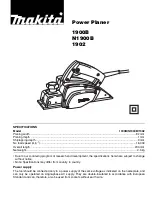
6
ENGLISH
Explanation of general view
1
Bolt
2
Drum
3
Planer blade
4
Drum cover
5
Adjusting plate
6
Blade edge
7
Screws
8
Heel
9
Back side of gauge base
10
Inside edge of gauge plate
11
Gauge plate
12
Gauge base
13
Pan head screw
14
Planer blade locating lugs
15
Heel of adjusting plate
16
Set plate
17
Inside flank of gauge plate
18
Mini planer blade
19
Groove
20
Switch trigger
21
Lock button
22
Lock-off button
23
Start
24
End
25
Blade edge
26
Cutting line
27
Screw
28
Edge fence
29
‘‘V’’ groove
30
Front base
31
Align the ‘‘V’’ groove with the
edge of the workpiece.
32
Nozzle assembly
33
Chip cover screw
34
Chip cover
35
Fit pin on nozzle assembly into
this hole.
36
Sharpening holder
37
Wing nut
38
Blade (A)
39
Blade (B)
40
Side (C)
41
Side (D)
42
Limit mark
43
Screwdriver
44
Brush holder cap
SAFETY INSTRUCTIONS
ENA001-2
WARNING! When using electric tools, basic safety
precautions, including the following, should always
be followed to reduce the risk of fire, electric shock
and personal injury. Read all these instructions
before operating this product and save these instruc-
tions.
For safe operations:
1.
Keep work area clean.
Cluttered areas and benches invite injuries.
2.
Consider work area environment.
Do not expose power tools to rain. Do not use power
tools in damp or wet locations. Keep work area well
lit. Do not use power tools where there is risk to
cause fire or explosion.
3.
Guard against electric shock.
Avoid body contact with earthed or grounded sur-
faces(e.g. pipes, radiators, ranges, refrigerators).
4.
Keep children away.
Do not let visitors touch the tool or extension cord.
All visitors should be kept away from work area.
5.
Store idle tools.
When not in use, tools should be stored in a dry,
high or locked up place, out of reach of children.
6.
Do not force the tool.
It will do the job better and safer at the rate for which
it was intended.
7.
Use the right tool.
Do not force small tools or attachments to do the job
of a heavy duty tool. Do not use tools for purposes
not intended; for example, do not use circular saws
to cut tree limbs or logs.
8.
Dress properly.
Do not wear loose clothing or jewellery, they can be
caught in moving parts. Rubber gloves and non-skid
footwear are recommended when working outdoors.
Wear protecting hair covering to contain long hair.
9.
Use safety glasses and hearing protection.
Also use face or dust mask if the cutting operation is
dusty.
10. Connect dust extraction equipment.
If devices are provided for the connection of dust
extraction and collection facilities ensure these are
connected and properly used.
11. Do not abuse the cord.
Never carry the tool by the cord or yank it to discon-
nect it from the socket. Keep the cord away from
heat, oil and sharp edges.
12. Secure work.
Use clamps or a vice to hold the work. It is safer than
using your hand and it frees both hands to operate
the tool.
13. Do not overreach.
Keep proper footing and balance at all times.
14. Maintain tools with care.
Keep cutting tools sharp and clean for better and
safer performance. Follow instructions for lubrication
and changing accessories. Inspect tool cord periodi-
cally and if damaged have it repaired by an autho-
rized service facility. Inspect extension cords
periodically and replace, if damaged. Keep handles
dry, clean and free from oil and grease.
15. Disconnect tools.
When not in use, before servicing and when chang-
ing accessories such as blades, bits and cutters.
16. Remove adjusting keys and wrenches.
Form the habit of checking to see that keys and
adjusting wrenches are removed from the tool
before turning it on.
17. Avoid unintentional starting.
Do not carry a plugged-in tool with a finger on the
switch. Ensure switch is off when plugging in.
18. Use outdoor extension leads.
When tool is used outdoors, use only extension
cords intended for outdoor use.
19. Stay alert.
Watch what you are doing. Use common sense. Do
not operate tool when you are tired.






























